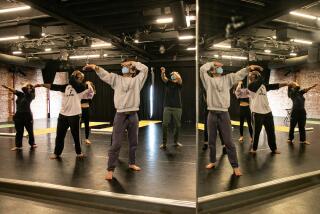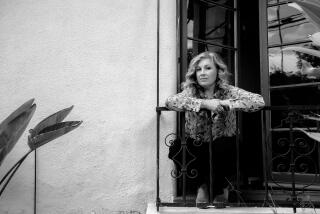‘All Rise’ is the first TV drama to tackle coronavirus. Here’s how they did it
It’s only a couple of hours after sunrise on a recent morning and, already, that frequent work-from-home question pierces through a fatigued internet connection.
“Edwin, can you hear us?”
He can’t. But it’s a temporary hiccup — one that’ll happen a few more times under these unusual circumstances. Because if you thought your virtual work meeting had its occasional twitches, try producing an hour of prime-time scripted television that way.
It’s what the team behind the CBS legal drama “All Rise” is doing as it creates an episode to close out its stunted season. Edwin Hodge, who has a guest role in the episode as the brother of the defendant, is having some technical difficulties. But nothing signing off and signing back in can’t fix.
Most of Hollywood’s productions powered down mid-March in response to the coronavirus outbreak, including “All Rise.” But some broadcasts — including talk shows, news programs and last week’s “Parks and Recreation” special — have managed to carry on by producing content from the safety of home. “All Rise,” which is produced by Warner Bros. Television and CBS Television Studios, becomes the first prime-time scripted program currently on air to join the remotely produced bandwagon with Monday’s episode.
“It’s ingenuity in the face of a situation,” says executive producer and the episode’s director, Michael M. Robin. “A good chunk of our audience are going to watch this, and they’re going to actually watch our characters go through what they’re going through.”
“Were you going to go down the hall and reboot the internet for a second?” Robin asks Ruthie Ann Miles, who plays legal assistant Sherri, after sensing her Wi-Fi connection is weak.
“That’s a little complicated because two other people [in my house] are on meetings throughout the whole day,” she says.
Written by showrunner Greg Spottiswood and Greg Nelson, the episode is inspired by current events: Los Angeles is under a mandatory shelter-in-place order, but the show’s fictional Los Angeles Superior Court still has cases needing attention. Adapting to this new normal, Judge Lola Carmichael (Simone Missick) finds herself having to preside over a virtual bench trial with Emily (Jessica Camacho) and Mark (Wilson Bethel) representing opposing sides of the case.
As concerns about the spread of the coronavirus began to escalate in the U.S. in early March, production was underway on the show’s 21st episode. In response, jugs of hand sanitizer were placed throughout the show’s soundstage on the Warner Bros. lot and, eventually, multiple hand-washing stations were set up, according to Missick.
But it became clear clean hands would not be enough.
The decision was made to halt production on the final two episodes of the season, just as it would for hundreds of other films and TV series across the industry.
But while going through notes over Zoom to finish post-production on the last set of episodes that had been shot, Robin started thinking about what else could be achieved remotely. Meanwhile, Spottiswood had been noodling with writing some socially distanced scenes that could be posted online. Then there was Thom Sherman, senior executive vice president of programming at CBS, who wondered if there was enough footage from the halted Episode 21 to fashion for broadcast.
“We were having a hard time wrapping our heads around it just like everybody else,” Sherman says. “We were trying to figure out: How much footage had each show shot of the last episodes they had, were we going to be able to complete seasons, how are we going to complete seasons with the episodes that were in the can ... we’re going through all these permutations.”
Conversations with former L.A. County Dist. Atty. Gil Garcetti, a consulting producer on the series, revealed that the court systems were grappling with how to navigate operations. At these early stages, a virtual trial had not been held, but discussions were beginning.
It seemed ripe for a virtual episode. Robin, Spottiswood, and fellow executive producers Len Goldstein and Dee Harris Lawrence began brainstorming the possibilities.
“It was daunting at first,” says Spottiswood. “And then, pretty quickly, I think we all realized that in actually a weird way, this was a good format for our show. Our show is about people in rooms, in the hallways, talking, arguing, connecting or not connecting.”
For Nelson, wrapping his mind around it came more easily because he got the news the day he saw the video of Jimmy Fallon and the Roots performing Gerry Rafferty’s “Stuck in the Middle With You” while in quarantine for an episode of “The Tonight Show: At Home Edition.”
Warner Bros. Television was in. CBS was in. The actors, who were told during what they thought was a virtual reunion, were stunned by the announcement. And excited.
“We were like, ‘What?’” Missick says. “And then the immediate thought is: ‘Now, wait, how are we going to do this?’”
Straight Up Technologies was enlisted to guide producers through the endeavor, and it was decided Cisco Webex — whose picture quality is sharper than that of most other services — would be their primary video-conference tool. A private network was created for cast and crew to dial into; video feeds were isolated and recorded.
Producers then used VFX to create the necessary backgrounds — for example, one that mimics an L.A. County Men’s Central Jail cell. Exteriors of a desolate Los Angeles were shot by a cinematographer operating solo from a vehicle.
“I’m sorry, my eyelashes are literally flying off,” Missick says, just as the cast is about to begin another take. She rises from her chair to find a mirror so she can wiggle the strip of fake strands into place while her co-stars use the time to rehearse dialogue timing. At another point, Bethel teases Camacho about how intently she is staring at her compact mirror to tame her fly-away hairs with a toothbrush.
The cast had to familiarize themselves with new tasks for this episode — taking care of their own hair, makeup, lighting, set design and props. They virtually scouted locations in their homes that would best suit the episode. Virtual tech runs tested the strength of the actors’ Wi-Fi connections; the show’s production assistant, Chance Bostick, disinfected, boxed up, and delivered cords and ring lights; and costume designer Janelle Nicole Carothers conducted virtual fittings with clothes she sent over.
“There was still that feeling of, ‘Is this safe? Like it’s been it’s been in transit for two days,” Missick recalls. “ I’m Googling: ‘Can you get the coronavirus from fabric?’ And you see, not with cotton, but yes with copper. And jeans have copper! So you’re like, I do not know yet what the right thing to do is.”
“Jessica, sorry, I know this is a weird thing where you have to look to your right for where Mo [McRae] is going to live,” Robin says, guiding her through the visuals of what the screen will look like for viewers. “So if you want to put a little sticky [note] over there.”
“You know what, yeah, I think I’m going to have to do that,” Camacho says. “Can you give me one second?”
“And Mike, where is Mo to me?” Bethel asks, referring to the actor who plays his defendant, Kurt.
“He’s hard right,” says Robin, whose twin 12-year-old daughters made the occasional cameo in his video feed. “Your other right. And your client is above you.”
Then there was the matter of acting while staring at a computer monitor.
Shooting through a virtual conference room presented unique obstacles in creating a natural performance — whether it was discovering where one’s line of vision should be or performing when multiple people were on the monitor, like the episode’s courtroom scene that featured seven actors. (The grid layout in the episode that will air is not what the actors saw on their monitors as they performed.)
Worried it impeded her performance, Missick asked production to send a screenshot of the scene’s final configuration, then taped photos of the actors to her monitor as a guide. But that meant not being able to build a performance using the same visual cues as usual.
“I would tape these pictures back up onto the screen and used my imagination and took a lot of trust in knowing who these people are and knowing these characters’ relationships, and really listening, because I wasn’t always able to see and connect with them in that way.”
It took six 10-hour days to shoot the episode, which featured a crew of about 55 people in production and post production. The closing moments will feature a dance party, in which many of the crew members participated. (Not all of the show’s regular crew worked on the virtual episode, but all crew were given at least three weeks of pay when production stopped.)
Sherman says there have been discussions about other shows on the CBS roster producing a virtual episode but no decisions yet.
“We’ll see how this goes,” he says.
More to Read
The complete guide to home viewing
Get Screen Gab for everything about the TV shows and streaming movies everyone’s talking about.
You may occasionally receive promotional content from the Los Angeles Times.







